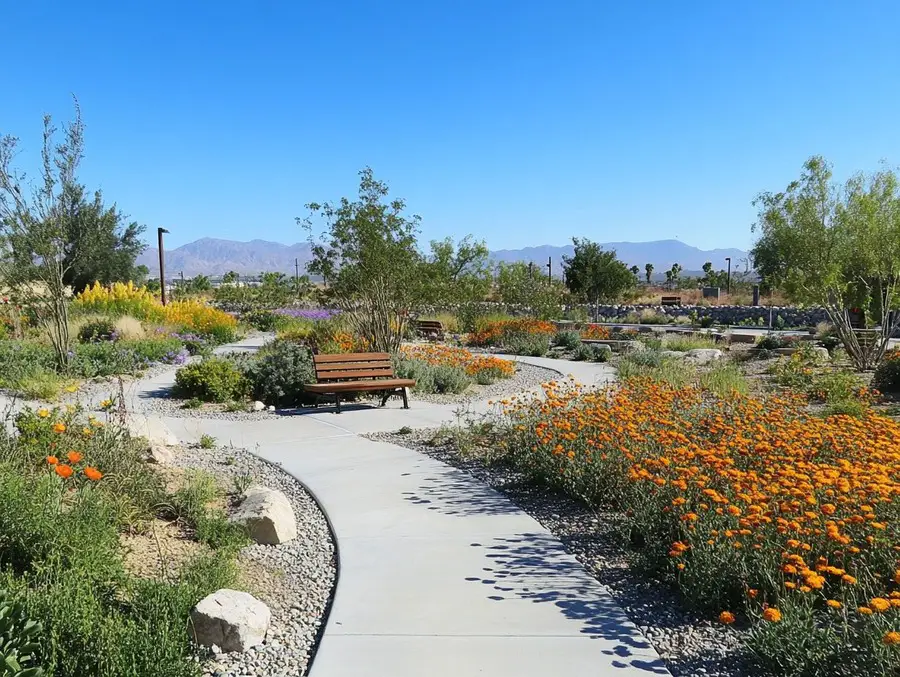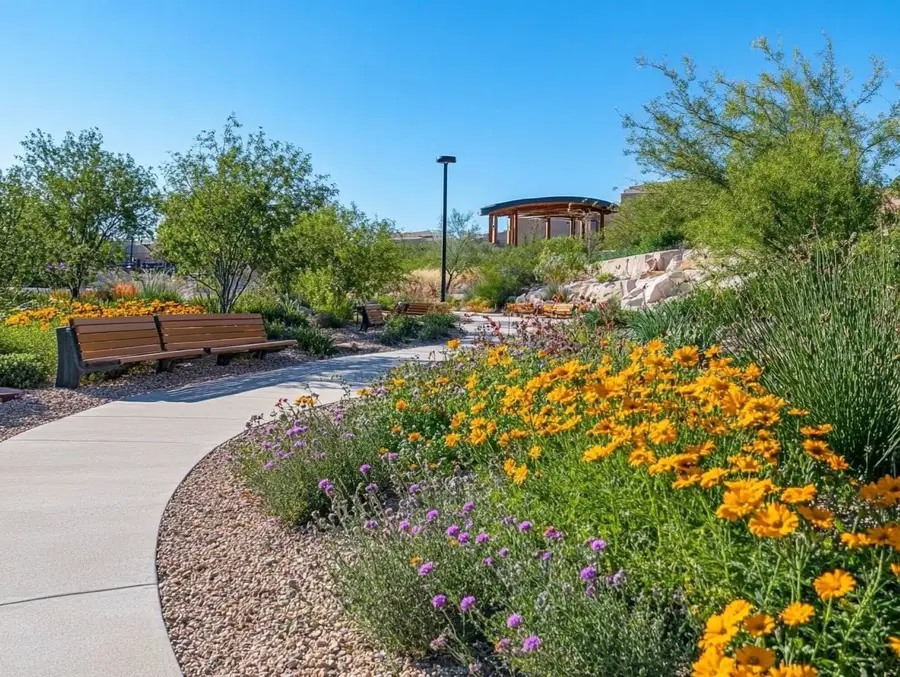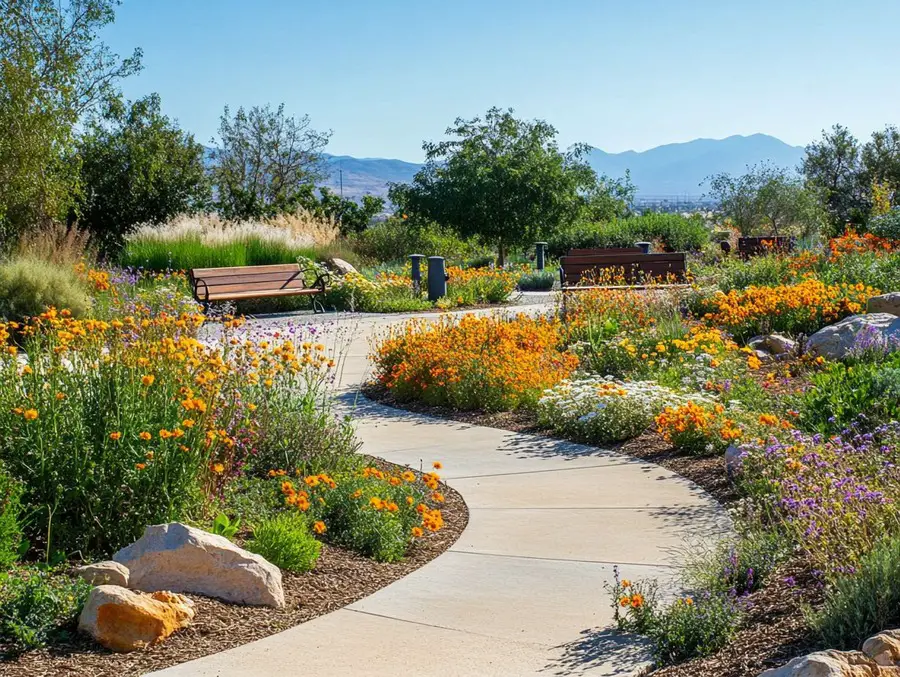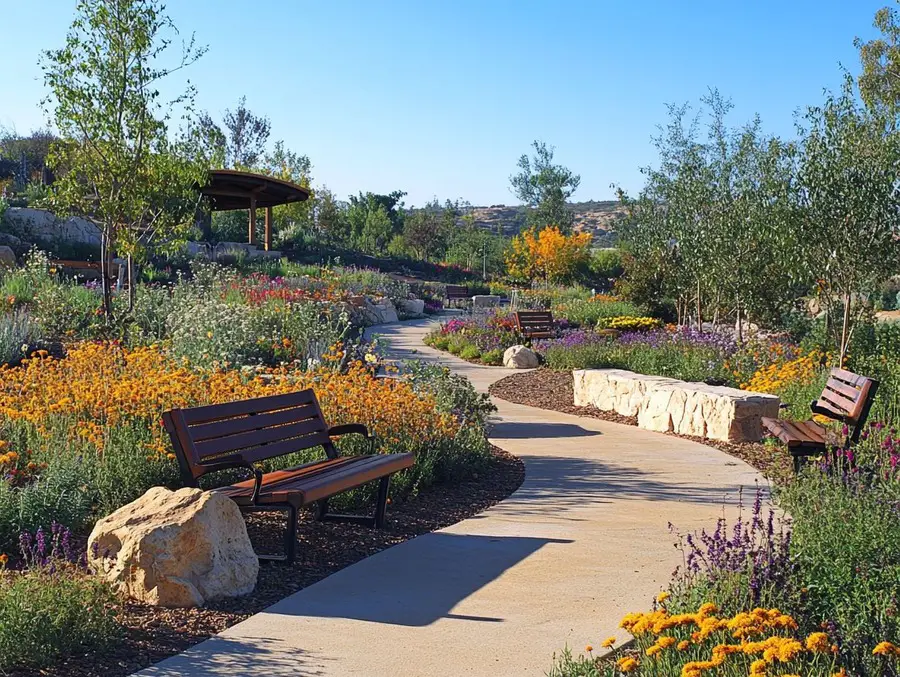
When it comes to water conservation and sustainability, xeriscaping in public spaces offers a game-changing solution.
Public parks and gardens often require significant upkeep, and traditional landscaping methods can drain resources.
By embracing drought-resistant plants and efficient irrigation, communities can transform shared spaces into thriving, eco-friendly landscapes that save water, reduce costs, and enhance biodiversity.
Xeriscaping in Public Spaces Key Takeaways
- Xeriscaping in public spaces focuses on using drought-tolerant plants and efficient irrigation to conserve water and lower maintenance costs.
- This sustainable landscaping method enhances biodiversity, reduces environmental impact, and creates inviting, eco-friendly urban areas.
- Ideal for parks and gardens, xeriscaping transforms shared spaces into thriving, resource-efficient environments.
Xeriscaping in Public Spaces: Transform Urban Landscapes
Xeriscaping is a landscaping approach that puts water conservation and sustainability front and center, making it a fantastic choice for public spaces.
In this article, you’ll dive into the definition and principles of xeriscaping, uncovering the many environmental and economic benefits it brings.
It’ll walk you through the design process, share tips on selecting the best drought-tolerant plants, and provide practical steps for implementation and maintenance.
Plus, you’ll get inspired by case studies that showcase successful xeriscaping projects, demonstrating how this method can truly transform your community.
What is Urban Xeriscaping?
Xeriscaping is a clever landscaping method that’s all about conserving water and making your outdoor spaces more sustainable, especially if you live in arid or semi-arid areas.
This approach uses xeric plants, drought-resistant species that don’t need much water to thrive, making it a fantastic option for urban landscaping.
By embracing eco-friendly design and sustainable practices, xeriscaping helps you save water, boosts biodiversity, and enhances soil health in public spaces.
All of this contributes to a more resilient environment that you can feel good about.
Definition and Principles
The 7 principles of xeriscaping are all about creating landscapes that need minimal watering by using sustainable practices and focusing on native plants that thrive in your local conditions.
This approach not only saves water but also helps restore the ecosystem and boosts biodiversity, making it a smart strategy for urban landscaping.
By incorporating thoughtful design elements, like strategically placed hardscaping and efficient irrigation systems, you can work with these principles to cut down on resource waste and encourage your plants to be more self-sufficient.
Choosing drought-resistant species means you won’t have to water constantly; your landscape can flourish with just a little help from you.
For example, a successful xeriscape garden might include native plants like lavender or succulents, showing off their resilience and adaptability.
Optimizing soil quality and using mulch cover are also key principles that help retain moisture and keep your soil healthy.
This holistic approach ultimately creates a beautiful balance between aesthetics, functionality, and caring for the environment.
Benefits of Xeriscaping in Public Spaces

Xeriscaping brings a ton of benefits to public spaces, transforming them in a way that not only makes the outdoors look better but also encourages community involvement.
By using water-efficient landscaping techniques, you can help municipalities cut down on water costs while championing environmental stewardship.
Plus, when you incorporate native plants and drought-tolerant landscaping, you’re doing your part for climate adaptation and biodiversity conservation.
It all plays a key role in restoring the ecological balance in urban areas.
Environmental and Economic Benefits
The environmental and economic benefits of xeriscaping in public spaces are pretty impressive.
You’ll find that it significantly cuts down on water usage and lowers maintenance costs, all while improving the ecological footprint.
By incorporating drought-resistant plants and smart irrigation systems, your community can save a chunk on water bills and cultivate healthier public parks and gardens.
These practices do more than just conserve water; they also reduce the need for chemical fertilizers and pesticides, which helps cut down on pollution runoff.
Take a look at a case study from Phoenix, Arizona: xeriscaping can slash water use in landscaping by up to 50% compared to traditional methods.
Plus, a report from the American Society of Landscape Architects shows that you can save an average of $35 per year for every square meter when you use xeriscaping.
These statistics really highlight how making the switch to xeriscaped environments not only conserves water but also boosts biodiversity, attracting native wildlife and fostering a more sustainable community vibe.
Designing a Xeriscape for Public Spaces

When you’re designing a xeriscape for public spaces, there are several key factors you need to consider to create a successful and sustainable landscape that can thrive in urban environments.
You’ll want to start by selecting the right drought-resistant plants and implementing effective irrigation systems.
It’s all about taking a thoughtful approach to enhance both the look and functionality of the space.
Plus, using xeriscaping guidelines and adding soil amendments can really boost soil health and reduce erosion.
This way, you’re not just creating a beautiful area but also fostering a resilient ecosystem that benefits the entire community.
Factors to Consider
When you’re designing a xeriscape, there are several key factors to keep in mind to create an aesthetically pleasing and functional landscape.
You’ll want to consider site analysis, climate adaptation, and the selection of native plants.
These elements ensure that your xeriscape is not just beautiful but also sustainable and easy to maintain.
For example, conducting a thorough site analysis means taking a good look at soil types, existing vegetation, and how much sunlight different areas get.
This info will help you figure out which plants will thrive in specific spots without guzzling too much water.
Climate adaptation is super important, too. By understanding your local weather patterns, you can plant strategically to cope with droughts or heavy rainfall, which means lower irrigation needs for you.
Plus, choosing native plants will not only make your landscape look great but will also support local ecosystems by attracting beneficial pollinators and wildlife.
When you blend all of these factors together, you’ll create a landscape that’s not just eye-catching but also environmentally responsible.
Plant Selection for Xeriscaping
Choosing the right plants is key to a successful xeriscape, especially when it comes to picking the best drought-tolerant plants that can thrive in those dry conditions.
Native plants, ornamental grasses, and xeric plants are fantastic options since they need little maintenance and help support the local ecosystem.
By thinking about plant diversity and adding some pollinator-friendly plants, you can boost biodiversity while creating some stunning and sustainable green spaces.
Best Drought-Tolerant Plants
When you’re on the hunt for the best drought-tolerant plants for your xeriscaping project, it’s important to think about a variety of xeric plants that will thrive in your specific environment while also looking great.
Incorporating native plants and seasonal color variations can make your landscape not only visually appealing but also ecologically friendly.
Consider species like agaves and succulents, which bring striking forms to the table and can handle arid conditions with minimal water.
Ornamental grasses, such as blue fescue, add some lovely texture and movement to your garden.
And don’t overlook culinary herbs like lavender and rosemary—they’re not just pretty; they also add a delightful fragrance to your space.
When you start adding these resilient plants to your landscape design, try grouping them based on their water needs and growth habits.
This approach will help create a cohesive look. Don’t forget to use mulch around the plants and think about designing pathways or raised beds to define spaces.
This way, each plant’s unique characteristics shine through, all while keeping your landscape low-maintenance and water-efficient.
Implementing and Maintaining a Xeriscape

Implementing and maintaining a xeriscape means you’ll want to follow a structured step-by-step process that keeps things sustainable and visually appealing in the long run.
From the initial planning stages to choosing the right irrigation systems and applying mulch for soil health, each step is crucial for taking care of your xeriscape.
Regular landscape maintenance is key to keeping your plants healthy and controlling soil erosion, making sure your xeriscape stays a vibrant part of the community.
Step-by-Step Process and Tips
To maintain an effective xeriscape, you should follow a step-by-step process that involves picking the right irrigation systems, applying soil amendments, and using mulch properly to keep that moisture in check.
This approach doesn’t just save water; it also boosts the overall health of your landscape.
Start by assessing what your plants specifically need to figure out the best irrigation options for them, like drip systems or soaker hoses, which do a great job of targeting those root zones.
Adding organic compost can really amp up your soil’s structure and nutrient content, helping those roots develop better.
Regarding mulch, go for materials like wood chips or rocks. They not only keep weeds at bay but also help reduce evaporation.
If you regularly monitor and adjust these elements, you’ll end up with a thriving, low-water landscape that showcases all the perks of xeriscaping.
Case Studies of Successful Xeriscaping Projects
Exploring case studies of successful xeriscaping projects shows you the real benefits and transformative impact of this sustainable landscaping practice in different communities.
Whether it’s urban parks or community gardens, these real-life examples highlight innovative designs and the positive environmental impact of xeriscaping.
By checking out these projects, you can pick up on effective landscaping techniques and see just how vital community involvement is for enhancing outdoor recreation and public health.
Real-Life Examples and Results
Real-life examples of successful xeriscaping projects really showcase the environmental impact and the aesthetic perks of this approach in public spaces.
You can see how thoughtful design and community engagement come together to create thriving green areas that not only save water but also boost biodiversity.
Take, for instance, the incredible transformation of a once-neglected park in Tucson, Arizona. The local community teamed up with landscape architects to swap out traditional turf for native plants and rock gardens, tackling water scarcity head-on.
At first, some residents were worried about how these changes might affect the park’s charm.
But once it was all done, the area turned into a vibrant habitat, attracting a variety of pollinators and slicing maintenance costs down significantly.
Now, this xeriscaped park has become a bustling community hub, offering educational workshops on sustainable gardening.
It really shows how powerful collective effort can be in making landscaping more sustainable.
Frequently Asked Questions
What is xeriscaping and why is it important in public spaces?
Xeriscaping is a type of landscaping that uses native plants and efficient irrigation methods to conserve water.
It is important in public spaces because it helps to reduce water usage and maintenance costs and creates a visually appealing and sustainable environment.
What are the benefits of implementing xeriscaping in public spaces?
There are several benefits to implementing xeriscaping in public spaces, including reduced water usage, lower maintenance costs, increased biodiversity, and improved sustainability.
Xeriscaping also creates a more visually appealing and inviting atmosphere for visitors.
How does xeriscaping save water in public spaces?
Xeriscaping saves water in public spaces by using drought-resistant plants that require less water, implementing efficient irrigation techniques such as drip irrigation, and reducing the need for watering through the use of mulch and other water-saving techniques.
What types of plants are typically used in xeriscaping for public spaces?
Native plants that are well-adapted to the local climate and require minimal water are typically used in xeriscaping for public spaces.
These may include succulents, cacti, grasses, and other drought-resistant species.
Is xeriscaping more expensive to implement in public spaces compared to traditional landscaping?
While the initial cost of implementing xeriscaping in public spaces may be slightly higher than traditional landscaping, the long-term cost savings in water usage and maintenance make it a more cost-effective option in the long run.
How can I encourage my local government to adopt xeriscaping in public spaces?
You can encourage your local government to adopt xeriscaping in public spaces by educating them about the benefits and providing examples of successful xeriscaping projects in other cities.
You can also gather support from community members and present a petition or proposal to local officials.
An Introduction to Xeriscaping: Water-Saving Garden Ideas
Benefits of Xeriscaping: Save Water, Time, and Money
What is xeriscaping? A beginner’s guide to drought-tolerant landscaping
